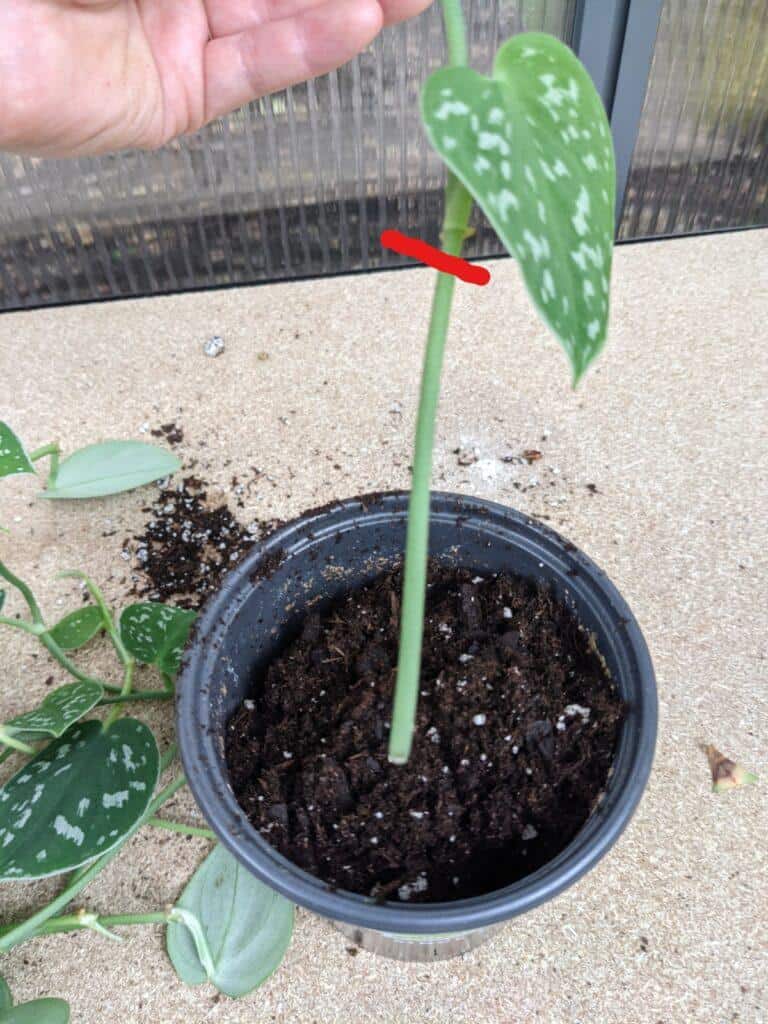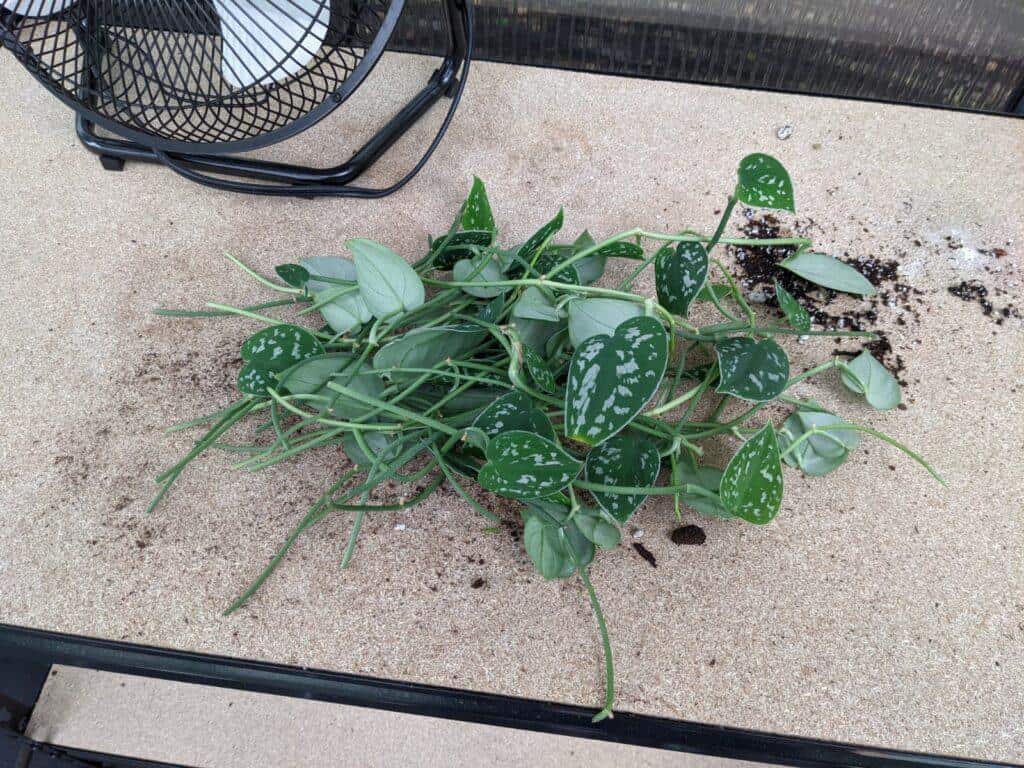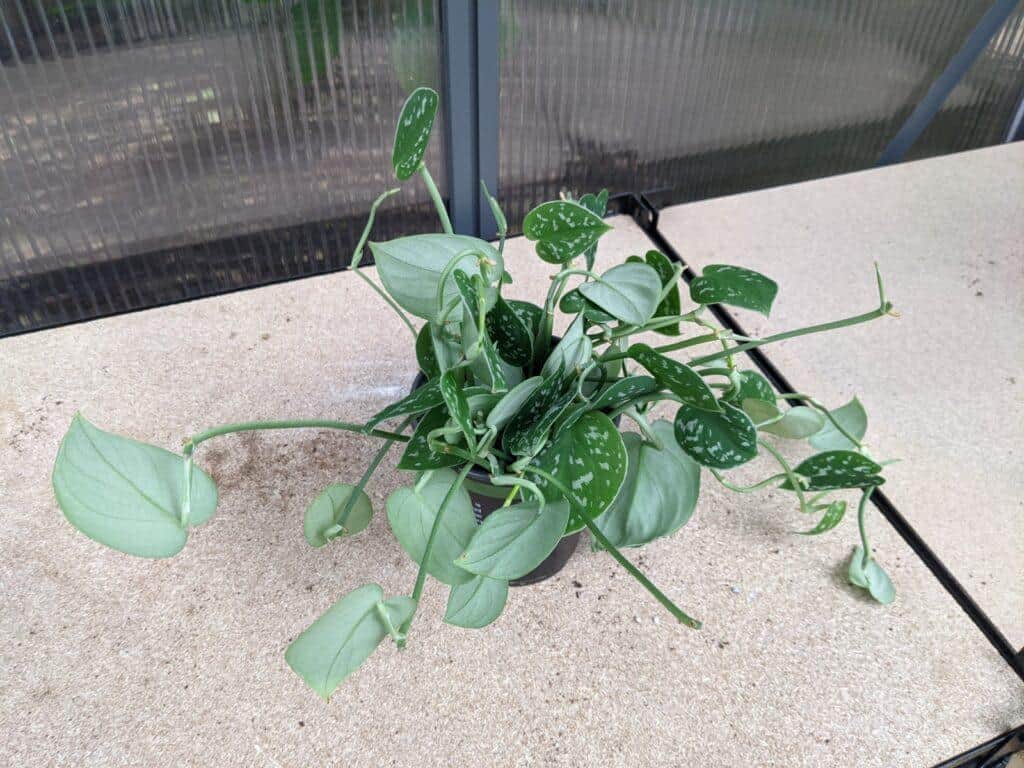Silver Pothos Propagation and Trimming
It's time for another plant maintenance blog. My Silver Pothos, sometimes called a Satin Pothos, was getting a little scraggly. It was time for a much-needed trim. Since Silver Pothos propagate so easily, I will also walk you through how to propagate a Silver Pothos. Below is a picture of my Silver Pothos after its trim!

About Silver Pothos
Silver Pothos, or Satin Pothos, are a variety of the popular houseplant Pothos. More common varieties are Golden Pothos, Marble Queen Pothos, and Neon Pothos. I'm a vocal fan of Pothos and I personally own all of these varieties. Pothos are a favorite because they are so easy to care for. They can tolerate many different light levels, and that's really the most difficult thing to deal with for indoor plants. Pothos are versatile as well because of their vining nature. You can have a hanging planter, you can string the vines around your room, or you can grow them up a moss pole.
Pothos often make the list for easiest houseplants to take care of. They also propagate readily, as you will see, so they are the perfect plant if you want to dip your toe into plant propagation. One caution with Pothos is that they are not cat and dog-safe. Keep them out of reach of your pets if they like to snack on your plants. See the table below for some Silver Pothos care basics. As mentioned before, Pothos can tolerate lower levels of light that you might get from north or east-facing windows.
| Light Needs | Watering Needs | Soil Needs | Fertilizing Needs |
| Bright indirect light. Tolerates low light. | Top inch should be dry before watering. | Well draining potting soil. | Monthly during the growing season. |
Trimming a Silver Pothos for Propagation
Where to Make the Cuts
My Silver Pothos was getting a little scraggly. Some vines were really long and it just threw the look and symmetry off for my plant. I decided it was time to give it a trim and to propagate the cuttings. When trimming, or pruning, your Silver Pothos you will want to make the cut just above a node. The node is where a leaf is, or was, connected to the vine. You may also have aerial roots growing from the node as well. You cut above a node because new growth will sprout from the node when your Pothos continues to grow.
How to Make Silver Pothos Cuttings
Trim your Silver Pothos to give it the look you want. They aren't fussy. Don't worry about the length of the cutting yet. Once you have trimmed all of the vines that you want off of your Pothos, we can start to think about propagation. You can propagate long vines with leaves, but I prefer not to. The long vines with leaves need more resources and your cutting has no roots so it can end up looking shriveled before the roots get going. I personally like to propagate a lot of short stems that really fill out a planter.
Regardless of how long you make your cutting, here are a few guidelines to help you. If you are cutting your trimmed vine into several pieces make sure each cutting has at least three nodes. Trim your cuttings so they have a node toward the end. The new roots will be growing out of the node and in my opinion, it's good to have that deeper in pot or water. Check out the photo below to see what I mean. I trimmed this cutting at the red line so that the node could be buried in the soil more securely. That also meant I had to remove the leaf.

When you're making the cuttings from your vines, keep in mind that your cutting does not have to have leaves on it just nodes. I did a whole post on propagating leafless Pothos vines with a detailed breakdown of the success rate for each variety of Pothos.
Back to topSilver Pothos Propagation from Cuttings
So now you have a pile of cuttings hopefully. You're almost there. In a few weeks, you should have rooted Silver Pothos cuttings. Now it's time to decide whether you want to water propagate your Silver Pothos or soil propagate. I generally prefer to soil propagate all plants because my intent, in the end, is to pot them in soil anyway, why add a step in between. However, I know people do like to water propagate. It can be fun because you actually get to see the roots grow and that's appealing to many of us. I'm going to cover soil propagation today because that's the method I used. If you want details about water propagating Pothos, read this blog too.

You may want to use rooting hormone with your Satin Pothos cuttings. Rooting hormone is a powder, or sometimes comes in a liquid, and is used to promote root growth. I use Garden Safe rooting hormone and have had the same container for years. If you have it, why not use it? However, you don't need it. You will still see successful Silver Pothos propagation without rooting hormone.
I just use regular indoor potting soil to propagate Silver Pothos. Nothing special and nothing to add. Most potting soils have some moisture retention properties and that can be good for your cuttings. If they dry out they are unlikely to successfully root. Whatever pot you use MUST have drainage. Plant propagation requires lightly moist soil but too much moisture can rot your plant.
Stick your cuttings into the soil. I like to try to get two nodes below the soil line if possible. That's two spots for roots to form. Make sure you have the cuttings facing the right way. This should be pretty straightforward with vines that have leaves, but not as easy if you have leafless vines. If you plant them upside down, they won't root.
Back to topHow to Care for Satin Pothos Cuttings
Now that you have placed your Silver Pothos cuttings in soil it's time to wait. It can take several weeks for roots to begin to form. In the meantime, keep the soil lightly moist. This may mean watering smaller amounts but more frequently than you do for a regular plant. You also want to keep your cuttings in some light but not too strong or direct light.

You can tell that your Silver Pothos propagated if you very lightly tug the vine and it stays. If there is some resistance, you've probably got some roots going. Another good indicator is if your cuttings sprout new leaves.
Generally speaking, it's unlikely that you will have 100% success propagating every Pothos vine you plant. That's okay! Your Pothos will grow quickly and soon you have more opportunities to propagate. You may notice some cuttings dry and shrivel or turn yellow and brown. Remove those and just enjoy the ones that root successfully.
Back to top
Add new comment